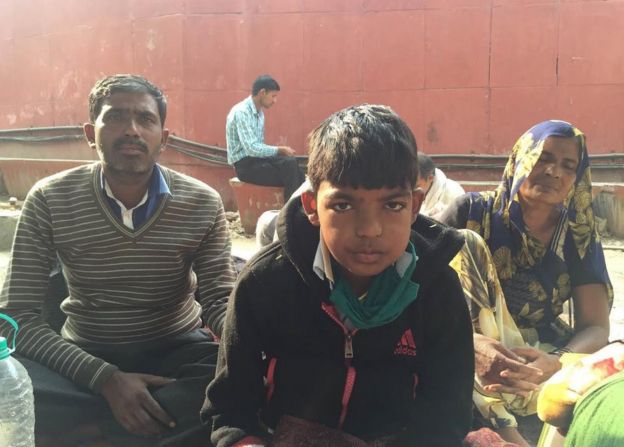India’s latest crackdown on black money is turning out to be a nightmare for the poor and the middle class.
Three days after 500 ($7) and 1,000 rupee notes were withdrawn as part of anti-corruption measures, hordes of panicky people are thronging banks and ATMS to deposit expired money and withdraw lower denominations to run their lives.

The queues are getting longer and angrier, and despite the government’s loud promises, banks and ATMs are quickly running out of cash. Limits on cash withdrawals are not helping matters much.
There are stories of desperate people burning sacks of illegal cash and of people unable to pay for cremations and hospital admissions. Wherever I go – my workplace, the community park, the local market- people are fretting over ways to get some of their own hard-earned money to run their lives.
Chaos
“I am so angry at the lack of planning on the part of the government before taking such an enormous step,” said Raju Sundaram, an office executive, waiting outside a bank in the south Delhi neighborhood of Saket.

‘My child has cancer, we can’t buy food’

Mahavir Singh, sitting outside Delhi’s famed All India Institute of Medical Sciences (AIIMS), is the picture of despair. The farm labourer has travelled nearly 80km (49 miles) from his village with his mother and his 10-year-old son Mohit Kumar, who suffers from blood cancer. The trio had brought 5,000 rupees for the trip to cover food, travel and lodging expenses, only to find that most of their money is now effectively worthless.
“We are facing major problems. Auto-rickshaw drivers and hotels are not accepting 500 rupee notes and that is all I have. It’s been such a struggle to feed my family, and my son will have to sleep on the pavement tonight,” he told the BBC.
His mother, Pushpa Devi, says they have already spent all the 100 rupee notes they have. “I have heard that there are some people who come here every evening to distribute food as charity, so I am hoping we can have that for dinner.”
A salesman of a shop selling mobile phones in an upscale Delhi suburb told that a man walked up to his shop on Wednesday with 3 million rupees in cash and offered to buy up his entire stock of iPhones. (He said the owner balked, and shut shop.) A politician in Bihar walked into a jewellery shop and bought gold ornaments worth 20 million rupees. In Kolkata, a dengue patient reportedly settled his 40,000 rupees hospital bills in coins.
There is also what is being called a thriving ‘discount scam‘: people are offering to buy stocks of scrapped notes at a premium, before laundering the expired money.
Desperate times
These are desperate times which require desperate measures. Last week, the central bank assured Indians that production of new notes had been “ramped up” to meet requirement, but banks are running out of cash very quickly. What is happening in far-flung villages at this point is anybody’s guess.
If the banks are unable to ease cash supplies soon, the reported goodwill for prime minister Narendra Modi’s so-called game-changing, path-breaking crackdown on illegal – or black – money could easily lead to an angry backlash. What is being also described as his political masterstroke – key state elections in Punjab and Uttar Pradesh are due early next year and his government’s “war on black money” could be an effective campaign slogan – could also backfire.
At the root of this chaos is the fact that India is an overwhelmingly paper currency country: some 90% of the transactions are done with cash. India’s cash-to-GDP ratio is 12%, some four times that of Brazil, Mexico and South Africa. More than half of Indians still don’t have a bank account, and some 300 million have no government identification. The two scrapped denominations – 500 and 1,000 rupees – account for more than 85% of the value of cash in circulation.
Shadow economy
Some of the cash is stashed and transacted in what is a booming “black economy” to evade taxes – politicians, property developers and dealers, traders, doctors, lawyers and sundry white-collar professionals are some of the biggest hoarders. A lot of the illegal cash is actually held in assets – real estate, jewellery – and in banks outside the country.
The size of India’s shadow economy is estimated at more than 20% of its GDP, and nobody quite knows how much of it is in cash and assets.
However millions of low income working class people, poor and roadside small businesses and traders hoard cash because they need the liquidity to run their lives and also, because there is no bank where they live. Supporters of the move say Indians will suffer some short-term disruption to make a dent in the shadow economy, but many are asking why the honest taxpayer and the poor should suffer most.
Demonetisation of currency – India’s third after two previous exercises in 1946 and 1978 – has predictably turned into an administrative nightmare, as a commentator feared, in a country with a strained state and creaky services. It has also opened a Pandora’s box, bringing out the worst – and occasionally, the best – in Indians. It also reminds me of Groucho Marx, who said, “While money can’t buy happiness, it certainly lets you choose your own form of misery.”


